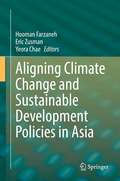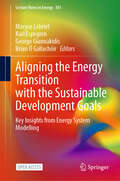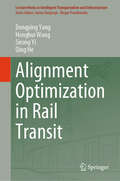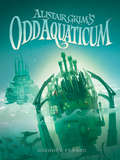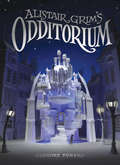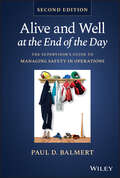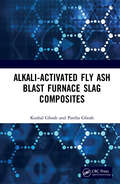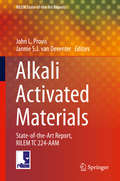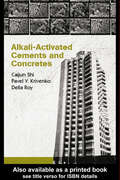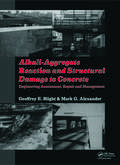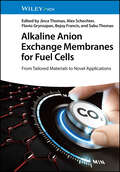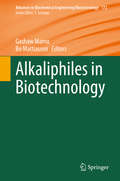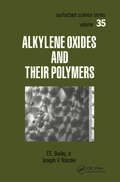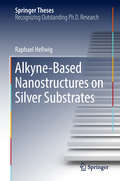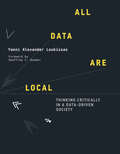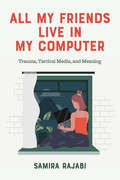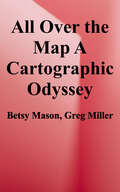- Table View
- List View
Aligning Climate Change and Sustainable Development Policies in Asia
by Hooman Farzaneh Eric Zusman Yeora ChaeThis book provides policymakers, researchers, and other interested audiences with knowledge on how to quantify and integrate and advance co-benefits in their decisions. It begins with an introductory chapter that provides an overview of the concept of co-benefits. This followed by a section that details quantitative approaches to estimate co-benefits, particularly in cities. A third section presents a series of case studies from the energy sector in Northeast and Southeast Asia. A final section focuses on new perspectives on co-benefits from linking climate change with biodiversity, social justice, and through new models of co-innovation. The book is particularly timely as many countries in Asia seek to achieve objectives in the national climate policies and the Sustainable Development Goals (SDGs). The climate emergency poses an increasingly severe threat to the health and well-being of more than a billion people in Asia. Policymakers in the region have sought to curb this threat by adopting clean energy, energy efficiency, and other sectoral policies. In some cases, these policies can bring additional benefits beyond mitigating climate change. These so-called “co-benefits” --ranging from improved air quality to better health to socioeconomic equity--could not only offset the costs of climate mitigation but also make Asia’s development more sustainable. Yet all too frequently policymakers lack the analytical methods and practical experiences to incorporate co-benefits into their decisions. This has created difficulties in aligning climate and sustainable development policies in Asia.
Aligning the Energy Transition with the Sustainable Development Goals: Key Insights from Energy System Modelling (Lecture Notes in Energy #101)
by George Giannakidis Maryse Labriet Brian Ó Gallachóir Kari EspegrenThis open access book brings together concrete analyses from around the world, spanning various scales, that shed light on strategies for implementing essential energy and climate transitions within the broader context of UN Sustainable Development Goal (SDG) imperatives. Specifically, the book exemplifies the advancement, adaptation, and utilization of energy systems models to address intricate policy issues around pathways to achieve net-zero emissions, enhance energy security, optimize investments, and understand their societal implications. It explores the intricate connections between the SDGs concerning energy, climate action, and other developmental priorities such as employment and economic growth, industrial innovation, urban development, responsible consumption and production, and collaborative partnerships. Organized into four sections, the book illustrates the necessary adjustments of energy system models to guide SDGs, evaluates the role of modeling to advance both renewable energy and energy security, and showcases how energy systems are harnessed to engage with international, national, and local policymakers. This book is available open access under a Creative Commons Attribution 4.0 International License via link.springer.com.
Aligning the Governance Structure of the NNSA Laboratories to Meet 21st Century National Security Challenges
by Committee on Assessment of the Governance Structure of the NNSA National Security LaboratoriesAligning the Governance Structure of the NNSA Laboratories to Meet 21st Century National Security Challenges is an independent assessment regarding the transition of the National Nuclear Security Administration (NNSA) laboratories - Los Alamos National Laboratory, Lawrence Livermore National Laboratory, and Sandia National Laboratories - to multiagency, federally funded research and development centers with direct sustainment and sponsorship by multiple national security agencies. This report makes recommendations for the governance of NNSA laboratories to better align with the evolving national security landscape and the laboratories' increasing engagement with the other national security agencies, while simultaneously encouraging the best technical solutions to national problems from the entire range of national security establishments. According to this report, the Department of Energy should remain the sole sponsor of the NNSA laboratories as federally funded research and development centers. The NNSA laboratories will remain a critically important resource to meet U. S. national security needs for many decades to come. The recommendations of Aligning the Governance Structure of the NNSA Laboratories to Meet 21st Century National Security Challenges will improve the governance of the laboratories and strengthen their strategic relationship with the non-DOE national security agencies.
Alignment Optimization in Rail Transit (Lecture Notes in Intelligent Transportation and Infrastructure)
by Qing He Dongying Yang Honghui Wang Sirong YiThis book deals with alignment optimization models for planning rail transit. After a general introduction to the basics of alignment optimization theory, it presents different alignment optimization methods to deal with different situations. It shows how to set up a 3D GIS scene for alignment interaction design, including location calculation of an alignment, alignment expression in a 3D scene, and the spacial relations between geographic objects, horizontal alignment, and vertical alignment. Further, it presents methods for solving more complex alignment optimization models, and shows for each different rail transit situation, how to calculate investment, energy consumption, and environmental influence. All in all, this book offers an interesting and timely reading to both researchers and professionals in the field of optimization theory, transportation planning, and GIS.
Alistair Grim's Odd Aquaticum (Alistair Grim #2)
by Greg Funaro"Dive head-, feet-, or face-first into this delicious danger." -- Kirkus Reviews, starred review When Grubb, an orphan and runaway chimney sweep, entered the wondrous world of the Odditorium, his life changed forever. Apprenticed to the mechanical marvel's strange proprietor, Alistair Grim, Grubb unfortunately must settle into his new position on the lam, as all of England is convinced that Alistair Grim is a villain. Grim, however, has come up with a plan to expose the real villain: Prince Nightshade, a wicked necromancer who wants the Odditorium's power source for himself. With the evil prince hot on their trail, Grim, Grubb and the rest of the Odditorium's crew embark on a perilous adventure to find the legendary sword Excalibur: the only weapon capable of penetrating Nightshade's magical suit of armor. As expected, their quest turns out to be anything but ordinary. Not only can the Odditorium fly, but it can also swim! And so the crew battens down the hatches and sets off on an underwater voyage to the otherworldly realm of Avalon, home to Excalibur. Along the way, they must battle a banshee assassin, sea monsters, and a witch who seeks revenge on Alistair Grim for stealing her magical objects. But that's not all. Unbeknownst to Grubb and the others, their fate has been written in an ancient Avalonian prophecy-a prophecy that holds the key to a destiny not even Alistair Grim could have imagined.
Alistair Grim's Odditorium (Alistair Grim #1)
by Gregory FunaroGrubb, age twelve (or thereabouts), has never known anything beyond his miserable existence as a chimney sweep, paid only in insults and abuse by his cruel master. All of that changes the day he stows away in the coach belonging to a mysterious guest at the inn that he is tasked with cleaning. Grubb emerges from Alistair Grim's trunk and into the wondrous world of the Odditorium. Fueled by a glowing blue energy that Grubb can only begin to understand, the Odditorium is home to countless enchanted objects and an eccentric crew that embraces Grubb as one of their own. There's no time for Grubb to settle into his new role as apprentice to the strange, secretive Mr. Grim. When the Odditorium comes under attack, Grubb is whisked off on a perilous adventure. Only he can prevent the Odditorium's magic from falling into evil hands???and his new family from suffering a terrible fate. Grubb knows he's no hero. He's just a chimney sweep. But armed with only his courage and wits, Grubb will confront the life-or-death battle he alone is destined to fight.
Alive and Well at the End of the Day: The Supervisor's Guide to Managing Safety in Operations
by Paul D. BalmertAlive and Well at the End of the Day Practical book showing professionals the “what to dos” and “how to dos” for effective safety leadership The Second Edition of Alive and Well at the End of the Day provides industrial leaders in operations with practical solutions to the tough safety leadership challenges they must manage. The book describes in detail the nature of those challenges (what makes them that tough) and offers proven best practices to successfully deal with them. The practices described in the book come from the author’s first-hand observation of leaders in operations who were successful in leading and managing safety performance. These best practices are defined and described in detail, allowing the reader to immediately and successfully put them into practice. In addition to providing “what to do” and “how to do that” for effective safety leadership, the book also explains “how it works” and “why to do it that way.” By taking this approach, the book provides deeper insight and understanding in addition to effective practices. The book’s contents are organized in a way that allows the reader the ability to match up chapters with specific challenges they are facing. In Alive and Well at the End of the Day, readers can expect to find discussion on: The practice of leadership, Moments of High Influence, Managing By Walking Around, and following all the rules, all the time Recognizing hazards and managing risk, behavior, consequences, and attitude, the power of good questions, and making change happen Managing accountability, safety meetings worth having, managing safety suggestions, creating the culture you want, and investing in training Understanding what went wrong, measuring safety performance, managing safety dilemmas, leading from the middle, and common mistakes managers make Leaders in industrial operations responsible for leading and managing safety performance, from CEOs to frontline leaders, can use Alive and Well at the End of the Day, in conjunction with the included study guide, to understand and implement a powerful process to improve the supervisor’s practice of safety leadership.
Alkali Activated Fly Ash: Blast Furnace Slag Composites
by Partha Ghosh Kushal GhoshThis book covers relevant synthesizing parameters, their interactions, and advantages of blending fly ash and blast furnace slag as source material, their relationship with mechanical properties and microstructure including guidelines to produce an optimal mix proportion. Further, it discusses related durability aspects, mechanical properties and reaction products and their inter-relationship. It explains phase characterization with XRD/SEM, change in the bond formulations with FTIR, FESEM and EDAX analysis. A mix design guideline based on empirical statistical concept has been put forward for professionals to manufacture customized activated fly ash composites in presence of slag. Aimed at graduate/senior undergraduate students, researchers in civil engineering, construction engineering, ceramics, material sciences, this book: Covers mechanical and microstructural properties, curing, durability of blended Alkali- activated composites with fly ash and blast furnace slag. Proposes a guideline for mix design on chemical compositions of ingredients, relationship of synthesizing parameters, workability, target strength. Describes sustainable green material manufacturing methodologies. Discusses issues like microstructural properties and reaction mechanism. Explores related modern experimental techniques like XRD, FTIR, MIP and so forth.
Alkali Activated Materials: State-of-the-Art Report, RILEM TC 224-AAM (RILEM State-of-the-Art Reports #13)
by John L. Provis Jannie S. J. van DeventerThis is a State of the Art Report resulting from the work of RILEM Technical Committee 224-AAM in the period 2007-2013. The Report summarises research to date in the area of alkali-activated binders and concretes, with a particular focus on the following areas: binder design and characterisation, durability testing, commercialisation, standardisation, and providing a historical context for this rapidly-growing research field.
Alkali-Activated Cements and Concretes
by Caijun Shi Della Roy Pavel KrivenkoThis is the first English-language book to review and summarize research in alkali-activated cements and concrete. It includes coverage of new types of binder, hydration and microstructure development of alkali-activated slag cements, mechanical properties and durability of alkali-activated slag cement and concrete.
Alkali-Aggregate Reaction and Structural Damage to Concrete: Engineering Assessment, Repair and Management
by Geoffrey E. Blight Mark G AlexanderSince AAR was first identified in 1940, it has been a subject dominated by studies of the mineralogy of AAR-susceptible aggregates, the chemistry of the AAR and related reactions and laboratory tests used to diagnose AAR and predict potential future swelling. Civil and structural engineers have found the literature bewildering and difficult to appl
Alkaline Anion Exchange Membranes for Fuel Cells: From Tailored Materials to Novel Applications
by Sabu Thomas Jince Thomas Alex Schechter Flavio Grynszpan Bejoy FrancisAlkaline Anion Exchange Membranes for Fuel Cells Build the fuel cells of the future with this cutting-edge material Alkaline anion exchange membranes (AAEMs) are cutting-edge polyelectrolyte materials with growing renewable energy applications including fuel cells, batteries, hydrogen electrolyzers and electrodialysis technologies. Their use in relatively new alkaline exchange membrane fuel cells (AEMFCs) is designed to produce cost-effective clean energy (electricity) produced by a chemical reaction. Rigorous studies are being conducted to meet the requirements of AAEMs precisely tailored for high anion conductivity and durability for future high energy efficient devices. Hence, over the past few years the academic and industrial scientific communities have explored various polymeric, composite and inorganic materials and studied their properties as a potential AAEM. The accumulated literature in this area of investigation is vast and in order to provide the community with the tools needed to strive forward, there is a clear need to condense this information in a single volume. Alkaline Anion Exchange Membranes for Fuel Cells meets this need with a comprehensive overview of the properties of these membranes and their applications. The book considers recent developments, common challenges, and the long-term prospects for this field of research and engineering. It constitutes a one-stop resource for the development and production of AAEM fuel cells and related electrochemical applications. Alkaline Anion Exchange Membranes for Fuel Cells readers will find: Discussion of electrochemical applications like redox flow batteries, water electrolysis, and many moreDetailed treatment of specially tailored cationic groups such as quaternary ammonium and guanidiniumExpert advice on efficient fabrication and electrode assembly Alkaline Anion Exchange Membranes for Fuel Cells is ideal for electrochemists, materials scientists, polymer chemists, electrical engineers, and anyone working in power technology or related fields.
Alkaliphiles in Biotechnology (Advances in Biochemical Engineering/Biotechnology #172)
by Bo Mattiasson Gashaw MamoThis book is devoted to alkaliphiles, their microbiology, biotechnological applications and adaptive mechanisms. Alkaliphiles are extremophilic organisms that are adapted to thrive in alkaline environments. Over the years, a wide variety of alkaliphiles belonging to domain Bacteria, Archaea and Eukarya have been isolated and studied. These organisms use various adaptive mechanisms to thrive in ‘extreme’ alkaline environments, and some of these adaptive mechanisms are of immense importance to a range of biotechnological applications. In this book, readers will learn about the adaptive strategies of alkaliphiles in colonizing alkaline habitats, with a main focus on: (1) the production of enzymes that are active and stable in the high pH environment, and (2) the production of acids that decrease the pH of their immediate surrounding environment. Enzymes that are operationally stable at high pH (also known as alkaline active enzymes) are desirable in several applications such as detergent formulating and leather tanning processes, and they are among the major selling enzymes and the most important industrial enzymes. The growing demand in many existing and emerging biotechnological applications led to the discovery, characterization, engineering and evaluation of diverse types of alkaline active enzymes. In addition to the use of these fascinating enzymes in biotechnological applications, readers will discover the mechanisms of action and stability of these enzymes at extreme pH. Studies have shown that some alkaliphiles decrease the severity of the high pH of their media by producing substantial amount of organic acids, which could be of great interest in various applications presented in this book. In addition to enzymes and organic acids, other products of biotechnological importance such as carotenoids, bioactive substances, and chelators have also attracted researchers’ attention. Whole-cells of alkaliphiles have been used as food and feed, and are also useful in environmental applications such as in waste treatment and construction.
Alkylene Oxides and Their Polymers
by F.E. Bailey Joseph V. KoleskeA comprehensive treatment of a large family of polymers useful in a wide range of applications in such fields as automotive, pharmaceutical, cosmetic, metal-working, mining, industrial coating, textile, construction, and home furnishings. Summarizes the chemistry and mechanisms; provides basic prepa
Alkyne‐Based Nanostructures on Silver Substrates (Springer Theses)
by Raphael HellwigAcetylenic precursors are important reactants for creating carbon-based architectures via linkage reactions. While their capability of forming intermolecular bonds is well investigated in solution, very few systematic studies have been carried out to create alkyne-based nanostructures on metal substrates under ultra-high vacuum conditions. Synthesizing extended and regular carbon scaffolds requires a detailed knowledge of alkyne chemistry in order to control reaction pathways and limit unwanted side reactions. Using the bottom-up approach on metal surfaces, the authors establish protocols to fabricate regular architectures built up by the on-surface formation of selective organometallic and C-C bonds with thoughtfully designed alkyne-functionalized monomers. The structural and functional properties of the resulting organometallic and covalent nanostructures are characterized by means of scanning tunneling microscopy. The results open up new perspectives in the fields of heterogeneous catalysis and the on-surface synthesis of functional interfaces under mild reaction conditions.
All Data Are Local: Thinking Critically in a Data-Driven Society
by Yanni Alexander LoukissasHow to analyze data settings rather than data sets, acknowledging the meaning-making power of the local.In our data-driven society, it is too easy to assume the transparency of data. Instead, Yanni Loukissas argues in All Data Are Local, we should approach data sets with an awareness that data are created by humans and their dutiful machines, at a time, in a place, with the instruments at hand, for audiences that are conditioned to receive them. The term data set implies something discrete, complete, and portable, but it is none of those things. Examining a series of data sources important for understanding the state of public life in the United States—Harvard's Arnold Arboretum, the Digital Public Library of America, UCLA's Television News Archive, and the real estate marketplace Zillow—Loukissas shows us how to analyze data settings rather than data sets.Loukissas sets out six principles: all data are local; data have complex attachments to place; data are collected from heterogeneous sources; data and algorithms are inextricably entangled; interfaces recontextualize data; and data are indexes to local knowledge. He then provides a set of practical guidelines to follow. To make his argument, Loukissas employs a combination of qualitative research on data cultures and exploratory data visualizations. Rebutting the “myth of digital universalism,” Loukissas reminds us of the meaning-making power of the local.
All Flesh Is Grass: Plant-Animal Interrelationships (Cellular Origin, Life in Extreme Habitats and Astrobiology #16)
by Joseph Seckbach Zvy DubinskyThis new book takes us through a journey from early life to modern agriculture. The thirty eight authors present current studies on the interrelation of plants-animals. This topic has always fascinated man, as evidenced even by the first chapters of Genesis. The world of aqueous and terrestrial fauna appeared on early earth only after the flora covered the areas with the green pigmentation. Almost all life depends upon sunlight via the photosynthesis of the botanical world. We read abut the harnessing of bee pollination of crops to make it an essential component of modern agriculture endeavor. Some plants seduce insects for pollination by their appearance (e.g., disguised orchids entice visitors); there is the production of sweet nectar as a bribe in flowers to attract bees, butterflies, and honey-sucking birds. A particular outstanding phenomena are the carnivorous plants that have developed trapping and digesting systems of insects and higher animals.
All Hands on Deck: Tools for Connecting Educators, Parents, and Communities (Corwin Connected Educators Series)
by Brad M. CurrieBring communities together for involvement that makes a difference! Impact your students in a positive way and join the leagues of educators who are learning to engage with students, parents, and communities using social media and Web 2.0 technologies. Featuring practical strategies that you’ll want to put to use right away, plus a dedicated series website for additional resources, this short and easy-to-follow book will show you: How smartphones and tablets can work for your goals The secret to getting—and keeping—parents involved How to inform, engage, and empower stakeholders How tools like Skype can connect the community at large The Corwin Connected Educators series is your key to unlocking the greatest resource available to all educators: other educators. Being a Connected Educator is more than a set of actions: it’s a belief in the potential of technology to fuel lifelong learning. "Currie harnesses the key element in today’s social media-infused school environment—‘Knowledge is Power!’ He illustrates just how we need to use this knowledge to support our schools, students, and communities." Daisy Dyer Duerr, Principal St. Paul Public Schools "This book provides educators with a diversified look at the connections schools can make with technology. It will inspire all of us, on a global scale, to stay active in ways once thought unimaginable." Salome Thomas-EL, Award-winning principal and author
All Hands on Deck: Tools for Connecting Educators, Parents, and Communities (Corwin Connected Educators Series)
by Brad M. CurrieBring communities together for involvement that makes a difference! Impact your students in a positive way and join the leagues of educators who are learning to engage with students, parents, and communities using social media and Web 2.0 technologies. Featuring practical strategies that you’ll want to put to use right away, plus a dedicated series website for additional resources, this short and easy-to-follow book will show you: How smartphones and tablets can work for your goals The secret to getting—and keeping—parents involved How to inform, engage, and empower stakeholders How tools like Skype can connect the community at large The Corwin Connected Educators series is your key to unlocking the greatest resource available to all educators: other educators. Being a Connected Educator is more than a set of actions: it’s a belief in the potential of technology to fuel lifelong learning. "Currie harnesses the key element in today’s social media-infused school environment—‘Knowledge is Power!’ He illustrates just how we need to use this knowledge to support our schools, students, and communities." Daisy Dyer Duerr, Principal St. Paul Public Schools "This book provides educators with a diversified look at the connections schools can make with technology. It will inspire all of us, on a global scale, to stay active in ways once thought unimaginable." Salome Thomas-EL, Award-winning principal and author
All My Friends Live in My Computer: Trauma, Tactical Media, and Meaning
by Samira RajabiAll My Friends Live in my Computer combines personal stories, media studies, and interdisciplinary theories to examine case studies from three unique parts of society. From illness narratives among breast cancer patients to political upheaval among Iranian-Americans, this book examines what people do when they go online after they have suffered a trauma. It offers in-depth academic analysis alongside deeply personal stories and case studies to take the reader on a journey through rapidly changing digital/social worlds. When people are traumatized, their worlds stop making sense, and All My Friends Live in my Computer explores how everyday people use social media to try and make a new world for themselves and others who are suffering. Through its attention to personal stories and application of media theory to new contexts, this book highlights how, when given the tools, people will make meaning in creative, novel, and healing ways.
All Over the Map: A Cartographic Odyssey
by Greg Miller Betsy MasonCreated for map lovers by map lovers, this rich book explores the intriguing stories behind maps across history and illuminates how the art of cartography thrives today. <p><p>In this visually stunning book, award-winning journalists Betsy Mason and Greg Miller--authors of the National Geographic cartography blog "All Over the Map"--explore the intriguing stories behind maps from a wide variety of cultures, civilizations, and time periods. Based on interviews with scores of leading cartographers, curators, historians, and scholars, this is a remarkable selection of fascinating and unusual maps. This diverse compendium includes ancient maps of dragon-filled seas, elaborate graphics picturing unseen concepts and forces from inside Earth to outer space, devious maps created by spies, and maps from pop culture such as the schematics to the Death Star and a map of Westeros from Game of Thrones. <p><p>If your brain craves maps--and Mason and Miller would say it does, whether you know it or not--this eye-opening visual feast will inspire and delight.
All The Dark Secrets: The First Heartwarming, Heartrending Saga In The Beloved Families Of Fairley Terrace Series (The\families Of Fairley Terrace Ser. #1)
by Jennie FeltonAll The Dark Secrets is a powerful saga in the Families of Fairley Terrace series from Jennie Felton, in the grand tradition of Katie Flynn, Dilly Court and Josephine Cox, of one woman's quest for happiness after a bitter tragedy, filled with romance, drama and triumph in adversity.Shattered by tragedy, can the Donovan family find happiness again?When terrible tragedy strikes at the local colliery, the residents of Fairley Terrace's ten houses suffer more than one loss and, for Maggie Donovan at number six, the world turns upside down. Turning for comfort to the one man she can trust, she finds a sudden and undeniable passion instead. But any future with Josh Withers seems a betrayal of her past, and Maggie realises the only way to survive is to conceal a very dark secret of her own...*Includes a preview of the next book in the series and bonus material from the author.*Don't miss Jennie's Families of Fairley Terrace series, which began with Maggie's story in All The Dark Secrets and continued with Lucy's story in The Miner's Daughter, Edie's story in The Girl Below Stairs, Carina's story in The Widow's Promise and Laurel's story in The Sister's Secret.
All The Dark Secrets: The first heartwarming, heartrending saga in the beloved Families of Fairley Terrace series (The Families of Fairley Terrace #1)
by Jennie FeltonThe compelling first book in the beloved classic series from 'one of the nation's favourite saga author' (Lancashire Post) in the grand tradition of Katie Flynn, Dilly Court and Josephine Cox.Jennie's heartwarming and heartrending sagas are richly praised!'Jennie Felton knows how to tell a cracking story and keep the reader gripped... if you enjoy reading books in the style of Catherine Cookson then this one is for you' Books With Wine and Chocolate'Another superbly woven and character-rich story from a saga author who writes from the heart' Peterborough Telegraph'Packed full of Jennie's signature strong heroines, this book will keep you guessing' MNR JournalShattered by tragedy, can the Donovan family find happiness again?When terrible tragedy strikes at the local colliery, the residents of Fairley Terrace's ten houses suffer more than one loss and, for Maggie Donovan at number six, the world turns upside down. Turning for comfort to the one man she can trust, she finds a sudden and undeniable passion instead. But any future with Josh Withers seems a betrayal of her past, and Maggie realises the only way to survive is to conceal a very dark secret of her own...*Includes a preview of the next book in the series and bonus material from the author.*Don't miss Jennie's the rest Families of Fairley Terrace series, which begins with Maggie's story in All The Dark Secrets and continues with Lucy's story in The Miner's Daughter, Edie's story in The Girl Below Stairs, Carina's story in The Widow's Promise and Laurel's story in The Sister's Secret.Plus look out for Jennie's page-turning standalones - The Stolen Child, A Mother's Sacrifice and The Smuggler's Girl - coming soon!
All The Dark Secrets: The first heartwarming, heartrending saga in the beloved Families of Fairley Terrace series (The Families of Fairley Terrace #1)
by Jennie FeltonA powerful new saga in the grand tradition of Katie Flynn, Dilly Court and Josephine Cox, of one woman's quest for happiness after a bitter tragedy, filled with romance, drama and triumph in adversity.When terrible tragedy strikes at the local colliery, the residents of Fairley Terrace's ten houses suffer more than one loss and, for Maggie Donovan at number six, the world turns upside down. Turning for comfort to the one man she can trust, she finds a sudden and undeniable passion instead. But any future with Josh Withers seems a betrayal of her past, and Maggie realises the only way to survive is to conceal a very dark secret of her own...For more of the Families of Fairley Terrace, look for the next compelling saga in the series, The Miner's Daughter.(P)2014 Headline Digital
